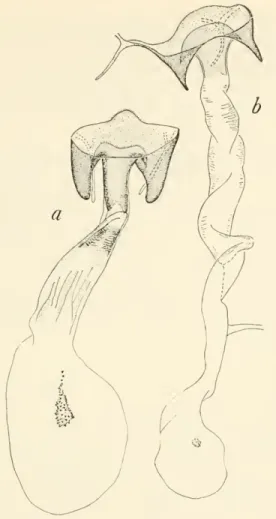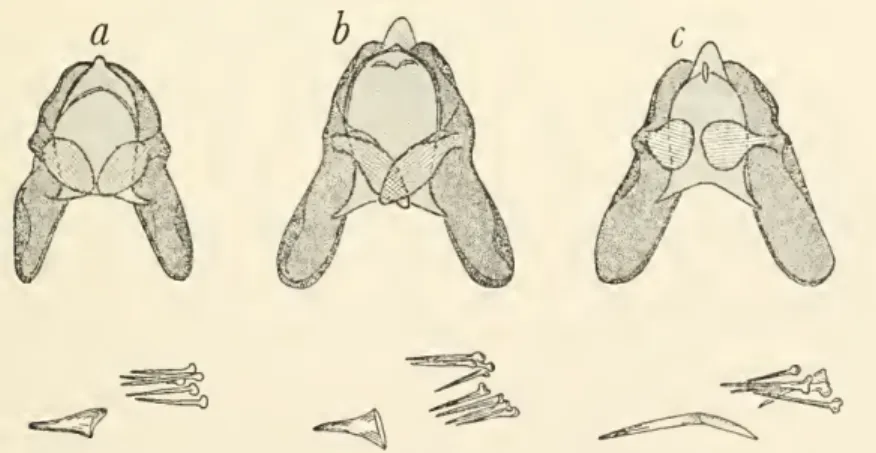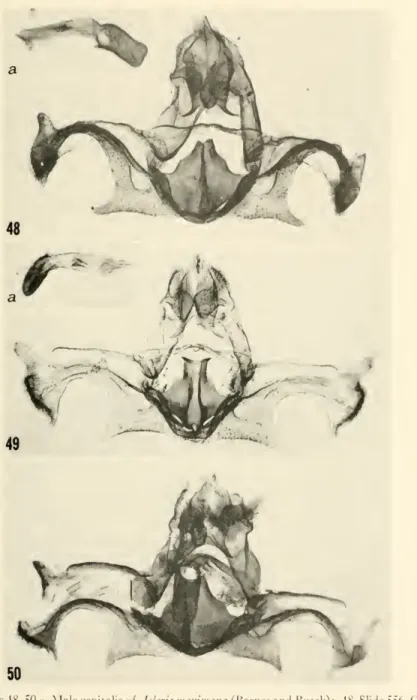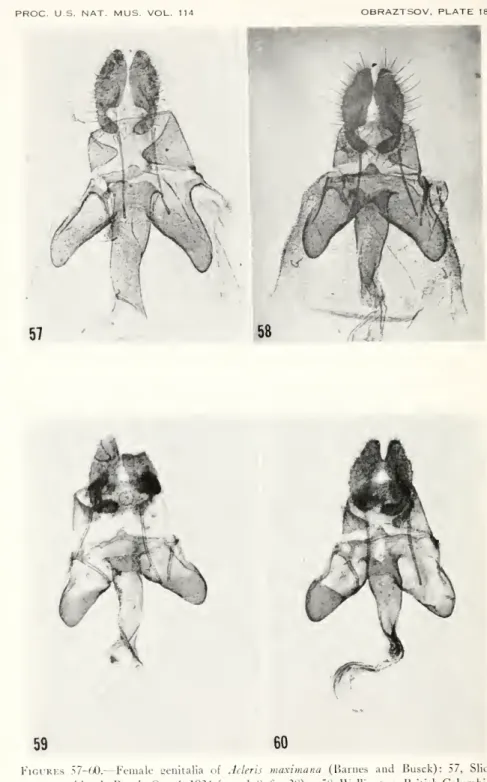The lateral lobes of the sterigma, which are slightly bent inward, are very characteristic of the female genitalia of this species. None of the authors who distinguish between latifasciana and comariana mention any lateral lines in the larva of the first order. Walsingham identified this species from two specimens now in the British Museum collection.
SOME MOTHS, GENUS ACLERIS — OBRAZTSOV 223
Until a complete revision of the variation of this species is done, it seems reasonable to designate all specimens with reticulation of forewings as form americana, to ignore the remaining characters of this form, and to treat all specimens without reticulation as form. The ground color of forewings varies from whitish gray or pale ochreous to gray and reddish brown; in some specimens the light ground is slightly touched with some of the above colors. SOME MOTHS, GENUS ACLERIS — OBRAZTSOV 225 The basal third of the forewing in this specimen is white, and the.
SOME MOTHS, GENUS ACLERIS — OBRAZTSOV 225 The basal third of the fore wing in this specimen is white, and the
From this connection arises a rather broad brownish-ochreous fascia that reaches the back before the tornus and is paler than the costal spots. Back of forewings whitish ochreous; costa with traces of markings of upper side and fine short greyish lines; tip bounded by a brown terminal line. In the female, the lateral lobes of the sterigma are wider than in cervinana; antrum forms no curvature of caudal angles; the sac of the ductus bursae is not constricted caudad.
SOME MOTHS, GENUS ACLERIS — OBRAZTSOV 227
USNM
Barnes and McDunnough, 1917, Checklist of the Lepidoptera of Boreal America, p. Peronea ferrugana from semiannula.—Forbes, [1924], Cornell Univ. The genitalia of this specimen correspond to those of the species described by McDunnough as hraunana. Teras viburnana.—Walker, 1864, List of specimens of lepidopterous insects in the British Museum, pt.
SOME MOTHS, GENUS ACLERIS — OBRAZTSOV 233
Teras trislana (in part).—Walker, 1863, List of specimens of lepidopterous insects in the British Museum, pt. Teras mixtana (in part).—Walker, 1863, List of specimens of lepidopterous insects in the British Aluseum, pt.
SOME MOTHS, GENUS ACLERIS — OBRAZTSOV 235
274.-Zincken, 1821, geb. Charpentier, The Zinsler, Rollers, Cockroaches and Ghosts of the Systematic Directory of Butterflies of the Vienna Area, f. 414.-Charpentier, 1821, The Zinsler, Rollers, Cockroaches and Ghosts of the Systematic Directory of Butterflys of the Vienna Area, f.
SOME MOTHS, GENUS ACLERIS — OBRAZTSOV 237
Acalla variegana aberration asperana.^Rebel, 1901, në Staudinger and Rebel Catalogue of theLepidoptera of the Palaearctic Faunal Area, vëll.
AMNH
McDunnough (1934) wrote about the variation of this species and noted a form with a black stripe from the base to the tip of the forewing. The powers of this form of senescence are pale gray with a pale pinldsh-brown discal cell. A fine black ray runs along the lower edge of the discal ceU, from the base of the forewing to a little below the tip, and becomes obliterated behind the discal cell.
A short, fine black line, parallel to and above this ray, is present on the apical part of the forewing. Terashastiana aberration coronana.- Wocke (not Thunberg), 1871, inStaudinger and Wocke, Catalog der Lepidopteren des europaeischen Faunengebiets, p. 232, no. 652a.
SOME MOTHS, GENIJS ACLERIS — OBRAZTSOV 243
The present author has had many specimens of Hastiana at hand, especially from Europe, in which the red-browed tuft was well developed. Viette (Museum National d'HistoireNatureUe, Paris), the present author had the opportunity to study Peronea caryosphena, described by E. The series examined consisted of two males and two females taken in Greenland in 1949 and identified by dr.
In the genitalia, the specimens from Greenland do not differ from Peronea walkerana described by J. The male genitalia of walkerana resemble those of Acleris hastiana (Linne), but they differ from them in the form of several parts.
SOME MOTHS, GENUS ACLERIS — OBRAZTSOV 245
As with the nominal form robinsoniana, Klots (1942) also changed the number of specimens of clemensiana in the collection.
SOME MOTHS, GENUS ACLERIS — OBRAZTSOV 247
Basal part, a little less than half of forewing, white or yellowish with a brown short oblique stripe or triangle at dorsum, and black well-developed raised scales on this stripe; entire outer part of forewing brown or yellowish brown with a slightly darker obliterated costal triangle. Some small groups of black raised scales at the border of these two so differently colored areas. Forewing yellowish brown, with a slightly darker indistinct costal triangle and black raised scales arranged as in previous variety.
Forewings with three parallel oblique ochreous bands, almost equally spaced: fu^st from about one-fourth of the bone to one-third of the back, the second from about the middle of the bone to two-thirds of the back, a third. The upper part of the second band is slightly darker, connected by a line with the third band below the bone.
SOME MOTHS, GENUS ACLERIS — OBRAZTSOV 249
250 PROCEEDINGS OF THE TPIE NATIONAL MUSEUM Vol. typical of the new species, and well separated from all known Acleris species. maculidorsana.—Walsingham, 1879, Illustrations of typical specimens of Lepidoptera Heterocera, pt. The basal group of the cornuti consists of two fairly strong, nearly equal needles; they were also seen in the above specimen from Whitesbog. Judging from the examined slides, the number of cornuti in the distal group varies from six to eight.
It should be noted that the spine of the vesica (the so-called "rose thorn") was directed inwards towards the aedoeagus tube in all slides examined.
SOME MOTHS, GENUS ACLERIS — OBRAZTSOV 251
The shape of the socii is somewhat similar to that in the Acleris hastiana group, but the sculpture of the outer surface of the aedoeagus is perhaps unique in the entire genus Acleris. The female genitalia of the new species are quite close to those of cervinana and suhnivana, and they differ from them in the shape of the antrum. National Museum, which drew the attention of the present writer to this and some other Acleris species in the collection of the above museum.
Head gray with dark scales in center and white bordered top; some pinkish brown scales on head. Forewings gray with pink-brown obliterated irregular markings formed by the area at the base.
SOME MOTHS, GENUS ACLERIS — OBRAZTSOV 253
Sterigma with long broad lateral lobes, twisted at tips and slightly bent inward, apex3^ Ostium bursae broad, sinuous. Antrum broad sclerotized tube, slightly longer than lateral lobes of sterigma, expanded kaiidad, excavatecephalad; anglesofantrum laterad from ostium bursae bent cephalad and rather long. The female genitalia of the new species are similar to those of Upsiana, but the antrum is shorter and wider, and the ductus seminalis is joined to the ductus bursae distant from the antrum; in Upsiana, the ductus seminalis opens directly from the antrum.
Base of costa, a large effaced costal spot in middle of discal cell and a longitudinal band on the latter, last quarter of wing and some outer veins with brown scales.
SOME MOTHS, GENUS ACLERIS — OBRAZTSOV 255
It has head, thorax, costa of forewings and their cilia orange-yellow, but most of the forewings are smoky grey, as in the form Cinderella. 1917, Checklist of Lepidoptera of Boreal America, p. Most of the specimens examined by the present author have the forewings 5-7 mm. The type specimen of Loi^hoderus gloveranus is a malein the collection of the British Museum (Natural History), as the present.
SOME MOTHS, GENUS ACLERIS — OBRAZTSOV 257 author had opportunity to study during his visit to London in 1958
SOME MOTHS, GENUS ACLERIS — OBRAZTSOV 259
Teras lipsiana (in part).—Walker, 1863, List of specimens of lepidopterous insects in the British Museum, pt.
SOME MOTHS, GENUS ACLERIS — OBRAZTSOV 261
All specimens examined for this paper were collected in Manitoba and Quebec, and there is some reason to believe that the range of nigrolinea is restricted to the northeastern part of the Nearctic. On only one point can the present author disagree with McDunnough, namely, his treatment of Fernald's oijerruginiguttan as a variation of nigrolinea. The head is whitish gray to ocher gray; as a rule, the scales are black-checked at the tips and (or) the middle.
Labial palpi externally colored with head, more or less checked black; internally white to pale ochre. Or, the forewings with a rather broad transverse fascia just behind the middle, consisting of two or three dark gray spots united or sep-.
SOME MOTHS, GENUS ACLERIS — OBRAZTSOV 263
To the tune of when Busck McDunnough wrote about his conception of Jerruginiguttana, the unique female type of this species already did not exist and was represented only by a few fragments that were useless for any diagnostic purpose. In this poor condition this type is now preserved in the United States National Museum, and the present author may describe it as a small part of the thorax containing one of the hind legs and the basal part of the hind wing. This description gives some reasons to believe that inferruginiguttana is a species related to Maximana and NigroUnea, but it is also entirely possible that Ferruginiguttana belongs to a different group.
National Museum, fully agrees with the original description of this species, which in the forewings should have a tuft on the fold near the base of the wing, an elongated stripe through the oblique stripe on the cell, and a spot between this and the outer edge, bright rust red." Busck himself was probably not entirely convinced of his view of ferruginiguttana, and there is only one female specimen from Colorado in the above collection with Busck's authentic label on the pin, reading "P.ferrugijiiguttana Fern. Some other specimens have this. In addition, ferruginiguttana appears on these slides as a second name, the first, written in India ink, being 'Peronea maximana'. In his unpublished manuscript notes of October 1919, Busck wrote.
SOME MOTHS, GENUS ACLERIS — OBRAZTSOV 265
The difference between disputabilis and maximana is more remarkable: the gnathos of the new species have no spiculation, the socii are longer and have a clearly different shape, the valva is more downwardly curved, the external concavity of sacculus is pillar, and the apical cornutus of the vesica has a flat base. The lateral lobes of sterigma of disputabilis are apicad more rounded and usually more curved than inmaximana. The variation in external characteristics of disputabilis is very great, but current knowledge of them is inadequate for separating geographical forms.
McDunnough (1934) gave a fairly accurate redescription of average maximana specimens, but does not fully cover the variation of this species. Some specimens have the forewings with fairly complete markings, but others these markings are obliterated or absent; dark gray spots are present in some. The spots, situated before the last third of the forewing, sometimes form a discontinuous transverse fascia.
One male (genitalia on slide prepared by A. Busck, Aug Campus, Utah State Agricultural College, Logan, Utah, at light, Populus balsamifera and apple (McDunnough, . 1934); Prunusemarginata, based on specimen data from Fallen Leaf Tipi Lake , Calif.— Holotype, male (genitalia on slide, prepared by A. Busck, Mar Goldstream, British Columbia, Aug. Blackmore); allotype, female, same data, Aug.
SOME MOTHS. GENUS ACLERIS — OBRAZTSOV 269
Type material of North American Microlepidoptera other than Aegeriidae in the American Museum of Natural History. Notes on the nomenclature and variation of British species of the Peronea group of Tortricidae. Illustrations of typical specimens of Lepidoptera Heterocera in the collection of the British Museum, Part 4.
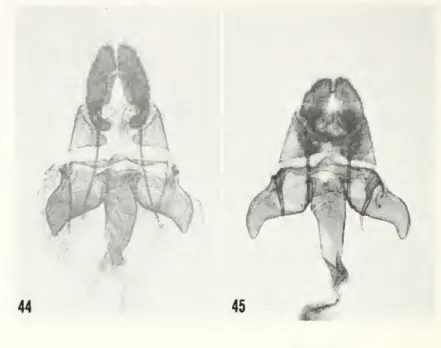
AMXH
